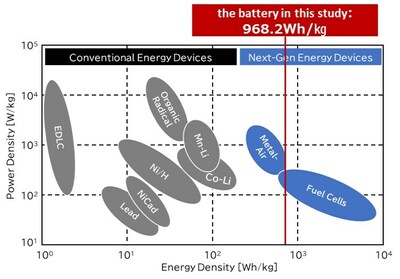
Pioneering Next-Generation Energy Devices with Environmentally Friendly "Metal-Air Paper Battery" Developed by AZUL Energy
Published by Todd Bush on April 10, 2024
SENDAI, Japan, April 10, 2024 /PRNewswire/ -- AZUL Energy proudly announces the development of a high-performance Magnesium-Air battery that is paper-based and activated by water.

A Metal-Air Paper Battery for Wearable Devices

Energy Density Comparison: Metal-air batteries have over three times the energy density of lithium-ion batteries on a weight basis.
>> In Other News: Johnson Matthey and bp Technology Chosen for the World's Largest Fischer Tropsch SAF Production Plant
A Metal-Air Paper Battery for Wearable DevicesEnergy Density Comparison: Metal-air batteries have over three times the energy density of lithium-ion batteries on a weight basis.
A research group, led by AZUL Energy Inc. (Sendai, JP), Professor Hiroshi Yabu from the Advanced Institute for Materials Research at Tohoku University, Senior Researcher Shinpei Ono from the Central Research Institute of Electric Power Industry, and Amphico Ltd (London, UK), has developed a next-generation energy storage device made from a safe, rare-metal-free AZUL catalyst and sustainable resources, including paper, magnesium, and carbon.
A significant breakthrough in energy storage technology, this battery generates electricity when immersed in neutral electrolytes like saline water, making it suitable for emergency power supplies and wearable devices. It achieves a voltage of 1.8V, an output exceeding 100mW/cm2, and a high capacity of 968.2Wh/kg.
Background
Conventional batteries use rare metals with limited reserves and high environmental impacts through mining, toxic heavy metals, and plastics. This research aimed to develop a sustainable and effective alternative in response to the growing demand for high-performance and environmentally friendly energy storage and usage.
Achievements
Although other "Metal-Air Paper Batteries" have previously been developed, they provided insufficient voltage and output, making them impractical.
In this study, the Magnesium-Air Battery provided a voltage of 1.8V, an output exceeding 100mW/cm2, and a high capacity of 968.2Wh/kg, representing a remarkable achievement. It was made using abundant and environmentally friendly materials, including magnesium, paper, and carbon, and a safe, rare-metal-free AZUL catalyst.
Future developments
Since our inception, AZUL Energy has focused on developing Metal-Air Batteries as next-generation energy devices. We have been working on enhancing their performance with our proprietary AZUL catalyst technology and have already improved the output and capacity of primary batteries. We are now entering the implementation phase for small primary batteries for sensors, hearing aids, drones, and more.
AZUL delivers excellent catalytic performance as a substitute for rare metals and is made from an environmentally safe blue metal complex pigment and carbon. It can fulfill various energy needs and is suitable for multiple applications, from small wearable devices to large batteries.
We continue to work on the charge-discharge compatibility and secondary battery conversion of Metal-Air Batteries, helping to foster a prosperous and sustainable society by introducing them into various applications.
Acknowledgments
Part of this research was supported by New Energy and Industrial Technology Development Organization (NEDO) International Co-Funding Program (JPNP14005).
About AZUL Energy
Established in 2019, AZUL Energy develops high-performance rare-metal-free catalysts invented by Tohoku University for next-generation energy systems. Although rare metal catalysts like platinum are used in hydrogen energy systems and are expected to reduce CO2 emissions, they are costly and have significant resource constraints. AZUL Energy's catalysts are lower cost and free of resource constraints, contributing to a more sustainable society.
SOURCE AZUL Energy Inc.
Subscribe to the newsletter
Daily decarbonization data and news delivered to your inbox
Follow the money flow of climate, technology, and energy investments to uncover new opportunities and jobs.
Latest issues
-
G20's Carbon Removal Gap Opens $1 Trillion Door
Inside This Issue 💰 G20's Carbon Removal Gap Opens $1 Trillion Door ✈️ Gold Standard Labels First Credits As Eligible For CORSIA Compliance 🌲 Chestnut Carbon Has Sold High-Integrity IFM Carbon Rem...
-
How Direct Air Capture Could Drop 75% in Cost
Inside This Issue 💨 How Direct Air Capture Could Drop 75% in Cost ⚡ Cache Power Advances 30 GWh Compressed Air Energy Storage Project In Alberta 🪨 Canada Nickel And The University Of Texas At Aust...
-
EPA Rule Unlocks $20B Biofuels Boom: The Decarbonization Players Who Gain
Inside This Issue 🌾 EPA Rule Unlocks $20B Biofuels Boom: The Decarbonization Players Who Gain ⛏️ DMS Georgia: World’s First Deep Mine Carbon Storage 💧 Dirty Water Boosts Prospects for Clean Hydrog...
Company Announcements
-
Topsoe Technology Enables Green Ammonia Production in the U.S.
Synergen Green Energy has chosen Topsoe as the technology licensor for its green ammonia plants to be built in the U.S. Topsoe will deliver its dynamic ammonia loop technology and its proprietary ...
-
A data-driven blueprint for identifying and designing nature-based voluntary carbon market (VCM) projects that deliver both carbon and biodiversity outcomes. NEW YORK, NY (November 3, 2025) — Carb...
-
Flagship system marks Plug’s first commercial electrolyzer deployment in the Netherlands and serves as a path for future Dutch hydrogen hub developments SLINGERLANDS, N.Y., Nov. 05, 2025 (GLOBE NE...
-
Gold Standard Labels First Credits As Eligible For CORSIA Compliance
Date: Nov 5, 2025 Location: Geneva, Switzerland Released by: Gold Standard Download Media Release Today, Gold Standard has for the first time labelled carbon credits as eligible to be used under ...